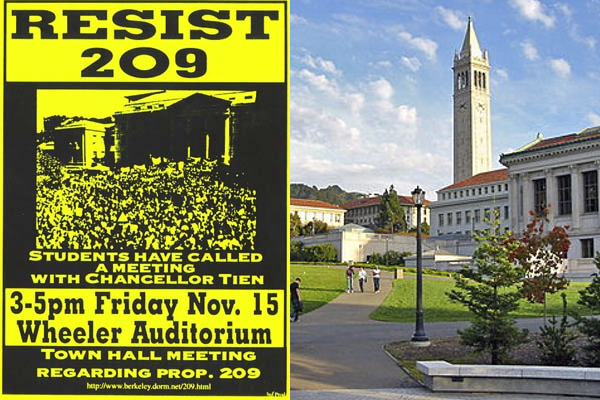Will California Voters End a 24-Year Ban on Affirmative Action?

This November, California voters will have the chance to repeal the state’s longtime ban on affirmative action. A state ballot measure, Proposition 16, will be the first major test of voter enthusiasm for social justice measures since the May 28 murder of George Floyd.
The ban on the use of affirmative action by state government was passed as a ballot measure (Proposition 209) in 1996 with strong support from Republican Governor Pete Wilson.
Proposition 16, if passed, would allow the state to use affirmative action programs in government hiring, contracting and university admissions. The measure’s most immediate impact would be on college admissions, where officials could once again use an applicant’s race as a factor in determining acceptance.
The ballot proposition, which would amend the state’s constitution, needs a simple majority to take effect. It was placed on the ballot after a June 24 vote in the Democratic-controlled state Senate. The Senate vote came shortly after the university board of regents voted unanimously to endorse the ballot measure and one month after the killing of George Floyd in Minneapolis.
Nine States Ban Affirmative Action
California is currently one of nine states that have a ban on affirmative action; the others are Washington, Texas, Florida, Michigan, Idaho, Nebraska, Oklahoma and New Hampshire. No state that imposed an affirmative action ban, has later had it repealed by voters or the legislature. In November 2019, Washington State voters narrowly defeated a measure to repeal that state’s ban on affirmative action.
How did California, now seen as a bastion of progressive legislation, pass a ban on affirmative action?
The 1990s were a period of rapid change and social unrest in the Golden State. Between 1988 and 1992 the state experienced a 42% increase in illegal immigration. In 1992, Los Angeles endured three days of rioting after the acquittal at trial of the LAPD officers who beat Rodney King.
A “tough on crime” mood infused state politics. In 1994, Pete Wilson won a tough re-election campaign and state voters approved two conservative-backed ballot measures, Propositions 184 and 187. The former, dubbed “Three Strikes and You’re Out,” lengthened criminal sentencing, while the latter denied health and welfare benefits to undocumented workers.
By 1996, Governor Wilson was contemplating a run at the Republican presidential nomination and saw the rise in illegal immigration as an issue he could use to his advantage. Ward Connerly, a Black businessman appointed by Wilson to the university board of regents, became the most prominent supporter of Proposition 209, the measure banning affirmative action. In speeches and editorials, Connerly characterized it as a “civil rights” measure.
Shifting Demographics
In 1996, the California electorate was 74% white. Proposition 209 passed by an overwhelmingly majority of white voters, 63-37%, while being opposed by majorities of Black, Hispanic and Asian voters, who constituted a small fraction of the electorate.
Today, the demographics of California have shifted. According to the Public Policy Institute of California, Whites in California make up only 42% of California’s adult population but 58% of the state’s likely voters. In comparison, Latinos comprise 35% of the adult population but just 19% of likely voters.
Asian Americans make up 15% of adults and 13% of likely voters. African Americans comprise 6% of both the adult population and likely voters.
The repeal measure will benefit from a well-funded “Yes” campaign, which has raised more than $3 million. The “Yes” campaign enjoys the support of the state’s leading Democrats and most major unions. Proposition 16 opponents, who have tapped Proposition 209 backer Ward Connerly as a spokesperson, have raised only around $100,000.
The Asian American community appears to be divided in its support. While State Controller Betty Yee, the state’s highest elected Asian American, supports Proposition 16, the Silicon Valley Chinese Association, a business group, strongly opposes it. The group’s president, Crystal Lu, said “We cannot let government choose winners or losers on the basis of your race or gender.”
Although the University of California (UC) and California State University (CSU) systems have been prohibited from using racial quotas in recent decades, they have implemented policies to diversify enrollment by giving weight to applicants’ economic status.
In 2019, White students comprised 22% of UC undergraduates and 21% of CSU’s, compared to the 36% of the adult population.
While Latinos comprise 39% of the state’s adults, they make up 25% of UC undergraduates and 44% of CSU’s. Note that in 2019, Latinos comprised 55% of high school graduates. Asian Americans comprise about 14% of the adult population but 33% of UC undergraduates, the largest share of any racial group
African Americans make up about 6.5 % of state’s adult population, but only 4% of undergraduates at both the UC and CSU systems.
While no major statewide polls have been conducted on Proposition 16, many of the state’s political experts believe it will pass. The November ballot will include Democratic nominees Joe Biden and Kamala Harris, the state’s popular U.S. Senator. California is strongly anti-Trump and a large turnout is expected, which should favor progressive candidates and social justice causes.